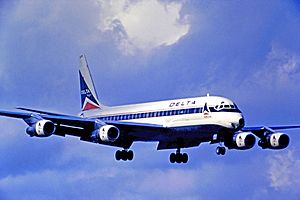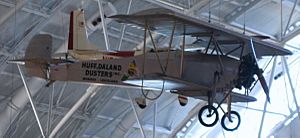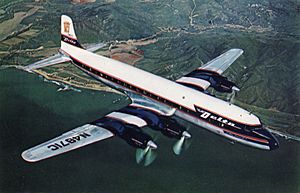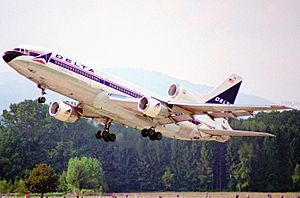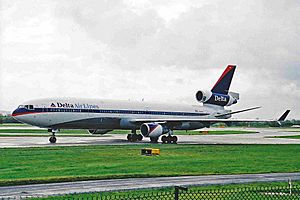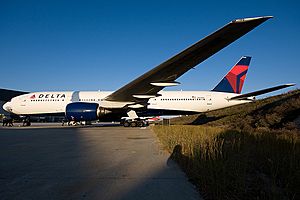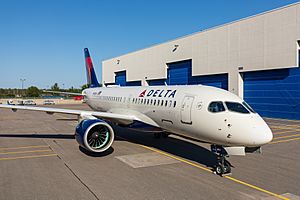History of Delta Air Lines facts for kids
Delta Air Lines is a big American airline. Its story began in 1925 with the world's first air service for spraying crops. This company was called Huff Daland Dusters Inc.. It started in Macon, Georgia, to fight tiny bugs called boll weevils that were harming cotton crops.
A smart leader named C.E. Woolman helped a group of investors buy the company. They started a new company called Delta Air Service on December 3, 1928. It was named after the Mississippi Delta region.
Passenger flights began in 1929, from Dallas, Texas, to Jackson, Mississippi. Soon, flights went east to Atlanta and west to Fort Worth, Texas. Passenger service stopped in October 1930 because another airline won the contract to carry air mail on that route.
Woolman and other investors then started Delta Air Corporation in 1930, using the old crop-dusting planes. The company began calling itself Delta Air Lines and started carrying mail from Fort Worth to Charleston, South Carolina. The name was officially changed to Delta Air Lines in 1945.
In the 1950s and 1960s, Delta was the first airline to fly new planes like the Douglas DC-8, Convair 880, and McDonnell Douglas DC-9. By 1970, all its planes were jets. Flights across the Atlantic Ocean began in 1978, with the first nonstop trips from Atlanta to London. In 1990, Delta was the first U.S. airline to fly McDonnell Douglas MD-11 jets. It became a top airline for transatlantic flights after buying most of Pan American World Airways' routes.
In 2005, the company faced money problems, partly because fuel costs went up. It worked through these problems and came out stronger in 2007. In 2008, Delta bought Northwest Airlines. Northwest continued to operate under Delta until the end of 2009. The two companies' computer systems and websites were combined in 2010, and the Northwest Airlines name was officially retired.
Contents
Delta's Early Years (1925-1940)
Delta's story began with a big problem: tiny bugs called boll weevils were destroying cotton crops in the 1920s. Scientists found that spraying insecticide powder from planes was the best way to fight them.
An airplane company, Huff-Daland Aero Corporation, built the world's first plane for crop-dusting. They started a company called Huff Daland Dusters Inc. on March 2, 1925, in Macon, Georgia. This was the world's first company to spray crops from the air. The company later moved to Monroe, Louisiana.
Collett E. Woolman was a key person. He helped start crop-dusting and passenger services in Peru. When he returned to the U.S. in 1928, he led a group of investors to buy Huff Daland Dusters.
The new company was named Delta Air Service, with its main office in Monroe. The name "Delta" came from the Mississippi Delta region. On June 17, 1929, Delta Air Service started flying 5-passenger planes from Dallas, Texas, to Jackson, Mississippi. By June 1930, Delta's flights reached Atlanta and Fort Worth, Texas.
This passenger service stopped in October 1930. Delta didn't win a contract to carry airmail, which was very important for airlines back then. So, Delta Air Service sold its planes. But Woolman and other investors bought back the crop-dusting planes and started Delta Air Corporation on December 31, 1930.
Delta got a new chance in 1934 after some changes in airmail laws. C.E. Woolman won a contract to carry mail on a new route from Charleston, South Carolina, to Fort Worth. Mail service began on July 4, 1934, and passenger service started on August 5. This is when the company began doing business as Delta Air Lines.
Growing Bigger (1940s-1950s)
In 1941, Delta moved its main office from Monroe to Atlanta.
Delta's routes started spreading north and south. In 1943, Delta added flights to New Orleans. In 1945, it added Chicago and Miami. The company officially became Delta Air Lines in 1945. Regular cargo (freight) service began in 1946.
Delta bought Chicago and Southern Air Lines in 1953. For two years, it flew as Delta-C&S. This added routes from Chicago and Detroit to Houston and New Orleans. It also gave Delta its first international route: New Orleans to Caracas, Venezuela, through Havana, Cuba. Delta's network grew to Washington D.C. and New York in 1956.
The Jet Age (1960s-1970s)
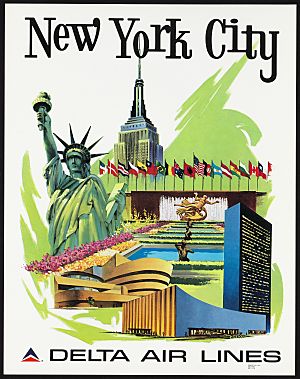
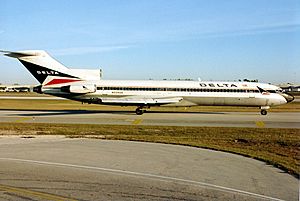
Delta started adding jet planes in the 1960s. The Douglas DC-8 began service in September 1959. Delta's new red, white, and blue triangle logo, called the "widget," looked like a jet's swept wing. Convair 880s were added in 1960, and DC-9s in 1965. By 1970, Delta became an airline that only flew jets.
In 1961, Delta's routes expanded west with the first nonstop flights between Atlanta and California. Delta bought Northeast Airlines in 1972. Delta also bought some Boeing 747-100s, but later sold them to China Airlines. Instead, Delta preferred the Lockheed L-1011. Flights across the Atlantic Ocean began in 1978, with the first nonstop service from Atlanta to London.
Modern Growth (1980s-1990s)
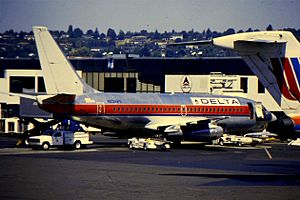
Delta started its first frequent flyer program in 1981. This program became SkyMiles in 1995. In 1982, the airline got its first Boeing 737s. Also in December 1982, Delta received its first 757 and 767-200. The 767 was named the Spirit of Delta. Employees, retirees, and community partners helped pay for it. This plane stayed in Delta's fleet until 2006.
In 1987, Delta merged with Western Airlines. This expanded Delta's reach. Flights across the Pacific Ocean began in 1987, with service from Atlanta to Tokyo.
In 1990, Delta was the first U.S. airline to fly the McDonnell Douglas MD-11 aircraft.
Delta grew a lot by buying most of Pan Am's European routes in 1991. Pan Am was having financial difficulties. This deal gave Delta the largest network of routes across the Atlantic among U.S. airlines. Because of these new routes, Delta became and still is the biggest U.S. airline for transatlantic flights.
In 1997, Delta reached a big milestone: it was the first airline to carry more than 100 million passengers in one year. Delta also started adding more routes between the U.S. and Latin America.
In 1998, Delta and United Airlines started a partnership. This allowed members of their frequent flyer programs to earn miles on both airlines.
Delta in the 2000s
In 2000, Delta joined with AeroMéxico, Air France, and Korean Air to form SkyTeam. This is a global airline alliance. Today, SkyTeam is the second-largest airline alliance in the world.
Changes to the Fleet

Delta started to simplify its fleet of planes. It began to retire its three-engine planes (trijets) and use more two-engine planes (twinjets). This made training pilots and maintaining planes easier. Now, all of Delta's active planes are twinjets. Delta is the world's largest operator of 767 aircraft.
- The Lockheed L-1011 was a very important plane for Delta for many years. The last L-1011 was retired on July 31, 2001. These planes were replaced with the Boeing 767-400.
- Delta's many Boeing 727s were replaced with Boeing 737-800s by 2003.
- Delta flew its last MD-11 flight on January 1, 2004. These planes were replaced with Boeing 777-200ERs. Many MD-11s were sold to cargo airlines like FedEx Express and UPS Airlines.
Financial Challenges and Recovery
In 2005, Delta faced serious financial difficulties and needed to reorganize its business. This included cutting jobs and expanding flights from its Atlanta hub.
On September 14, 2005, Delta filed for protection from its creditors. This meant the company needed to reorganize its debts. Interestingly, Northwest Airlines also filed for similar protection on the same day. Delta and Northwest would later merge.
During this time, Delta worked hard to reduce costs. Non-union workers' salaries were reduced, and executives took bigger pay cuts. The company also planned to reduce its number of employees. Delta aimed to return to making a profit by late 2007, which it achieved.

In 2007, Delta started offering on-demand movies and TV shows on longer flights. Live TV and music were free, and movies could be bought. This was similar to services offered by other airlines.
In November 2006, Delta started hiring back flight attendants and pilots.
US Airways' Attempt to Buy Delta
In November 2006, US Airways Group tried to buy Delta for $8 billion. Delta's management and employees were against this idea. Employees started wearing "Keep Delta My Delta" buttons to show their opposition.
On December 19, 2006, Delta rejected the offer. Delta said the merger would lead to worse customer service and possible job cuts. US Airways raised its offer to $10.2 billion in January 2007, but Delta's creditors rejected it. On January 31, 2007, US Airways gave up its attempt to buy Delta.
Coming Out of Financial Protection
On April 25, 2007, the court approved Delta's plan to reorganize. On April 30, 2007, Delta Air Lines officially came out of financial protection as an independent airline. Delta also showed off a new logo and a new paint design for its planes.
After this, Delta increased its flights at Los Angeles International Airport by 50%. This made Los Angeles Delta's second main hub on the West Coast.
Recent History (2010s-2020s)
Merger with Northwest Airlines
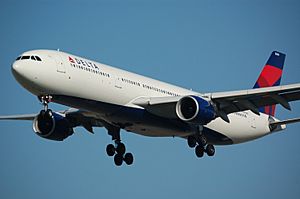
On April 14, 2008, Delta and Northwest Airlines announced they would merge. This created the world's largest airline under the Delta name. The combined airline had 786 planes.
Northwest's frequent flyer program, WorldPerks, joined Delta SkyMiles on October 1, 2009. The two airlines officially became one on December 31, 2009. Their reservation systems were combined on January 31, 2010, and the Northwest brand was officially retired.
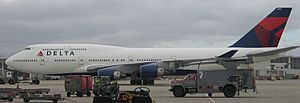
The U.S. Department of Justice approved the merger. They found that the two airlines' routes didn't overlap much, so it wouldn't harm competition.
After the merger, all of Northwest's planes were repainted in Delta's colors. Northwest's main airports in the U.S. were also changed to match Delta's operations.
Recent Events
In 2015, Delta partnered with China Eastern Airlines. Delta bought a small share in China Eastern.
In August 2016, thousands of Delta flights were delayed or cancelled. This happened because of a technology problem, leaving many people stuck around the world.
In September 2017, Delta flight 431 from San Juan to New York became well-known for flying away from Category 5 Hurricane Irma just before it hit Puerto Rico.
In October 2018, Delta received its first Airbus A220-100 plane.
In September 2019, Delta announced a partnership with LATAM Airlines Group. Delta bought a 20% share in LATAM. This partnership helps LATAM move away from its ties with the Oneworld airline alliance.
In March 2020, due to the global COVID-19 pandemic, Delta announced it would reduce its flight capacity by 40%. It also put up to 600 planes into storage. On June 2, 2020, all MD-88 and MD-90 aircraft were retired.
In 2021, after facing losses from the pandemic, Delta reported its first quarterly profit. This broke a streak of five quarters with losses. The company also announced it would buy more used Boeing 737s and lease Airbus A350s to prepare for a growing travel market.
Airlines That Became Delta
Delta Air Lines today is the result of many mergers throughout its history. Some of the airlines that became part of Delta include:
- Chicago and Southern Air Lines (merged in 1953)
- Northeast Airlines (merged in 1972)
- Northwest Airlines (merged in 2010)
- Republic Airlines (merged into Northwest in 1986)
- Hughes Airwest (merged into Republic in 1980)
- North Central Airlines (merged into Republic in 1979)
- Southern Airways (merged into Republic in 1979)
- Republic Airlines (merged into Northwest in 1986)
- Pan American World Airways (Delta bought some of its assets and routes in 1991)
- Western Airlines (merged in 1987)
Former Delta Airlines
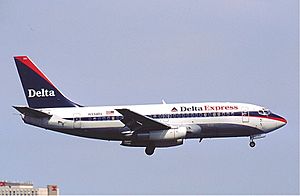
Delta also had some airlines that were part of its family but later stopped operating:
- Comair started in 1977 and was bought by Delta in 1999. It stopped flying on September 29, 2012.
- Delta Express started in 1996 to compete with low-cost airlines. It stopped operations in November 2003.
- Song started on April 15, 2003, to compete with JetBlue Airways. It was merged into the main Delta brand on May 1, 2006.
Plane Colors and Logos
For a long time, Delta's planes had different paint schemes. By the late 1930s, planes were mostly shiny metal with red and blue accents. In the 1940s, planes usually had a white top, metal bottom, and red-and-blue lines along the windows.
In 1962, Delta introduced the "Widget" logo. This was a triangular shape meant to look like a jet's swept wings. This logo and paint style stayed mostly the same for 35 years. Planes were mostly white with a blue line over the windows and a thin red line. The tail had an angled Widget logo.
In 1997, the paint scheme changed. The lines curved down over the nose of the plane. The tail was painted entirely blue with a curved red accent.
In 2000, the paint was changed again. The planes were all white with a three-color tail design (red, dark blue, and light blue) that looked like waving fabric. This was called "Colors in Motion."
When Delta became financially stable again in 2007, it introduced another new paint scheme. This one had an off-white body, a curved dark blue underside, and a dark blue tail. The tail featured a new, angled Widget logo, split into dark and bright red sides to look 3D. This has been Delta's main paint scheme since then, with small updates in 2015.


